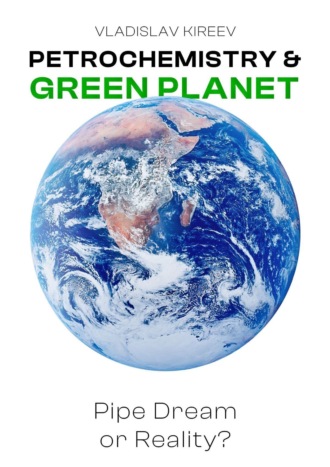
Полная версия
Petrochemistry & Green Planet: Pipe Dream or Reality?
Energy autonomy and the ability to export surplus “green” energy become additional incentives for innovation. However, it is not that simple; investments in new technologies require significant financial expenditures, and the payback period can stretch for decades.
Furthermore, not all regions offer equal opportunities for using renewable energy sources. For example, wind generation requires specific climatic conditions, and the efficiency of solar panels decreases in cloudy regions. Also, technological and infrastructural barriers shouldn’t be overlooked. Implementing new energy systems demands comprehensive retrofitting, which poses a challenge for already operating productions.
An interesting experience in this context is the partnership programs between petrochemical companies and manufacturers of equipment for renewable energy sources. Joint research and pilot projects allow adapting new technologies to specific conditions and evaluating their effectiveness.
At the same time, the green revolution in petrochemistry faces several challenges. The foremost and primary one is the high cost of implementing innovations, hindered by bureaucratic barriers and the inconsistency of regulatory frameworks across different countries, complicating the global dissemination of new technologies.
Nevertheless, the dynamics of change are quite promising. Against the backdrop of the global movement towards decarbonization and sustainability, innovations in the petrochemical industry are not just relevant – they become an integral part of the corporate strategy of the market’s leading players. Considering the accelerated pace of climate change, such an approach seems to be the only feasible path to a sustainable future.
CHAPTER №2
The Role of Legislation and Regulation in Transforming Petrochemistry into a More Environmentally Sustainable Industry
In modern society, the petrochemical industry is under the close scrutiny of environmentalists, politicians, and activists. With the growth and expansion of this sector, its negative impact on the ecosystem becomes increasingly evident – from atmospheric emissions to water pollution and waste management issues. In the era of the global climate crisis, the petrochemical industry faces the colossal challenge of transforming into an environmentally sustainable branch. Here, legislative initiatives play a key role and can provide the impetus for long-awaited changes.
One of the most pressing issues requiring immediate attention is the reduction of harmful emissions into the atmosphere. Government bodies and international entities are actively working on legislation that sets strict limits for various types of emissions – from vapors and gasses to aerosol particles. This is not only a technical imperative, but also an ethical one: adhering to air quality standards is directly related to the health of the population and the sustainability of ecosystems.
These legislative initiatives include setting threshold values for pollutants. They mandate the use of the most effective available technologies for emission reduction and standards for monitoring and reporting. These regulations are based on current scientific data and are adapted depending on various factors, such as levels of industrial development and climate conditions in different regions.

Per established standards, enterprises are required to install specialized equipment for pollution monitoring and conduct regular measurements. Non-compliance with the set norms can lead to serious legal and financial consequences, which can go from fines and sanctions to the loss of licenses and even litigation. Moreover, reputational risks in an era of information transparency cannot be underestimated. Thus, the petrochemical industry stands at a crossroads. It faces not only technological challenges but also socio-environmental ones, which can only be addressed through comprehensive collaboration of all interested parties: from government structures to scientific communities and the industry itself. This is not just a challenge for the future but an urgent matter of today. In the context of escalating global environmental concerns, legislative bodies around the world are reinforcing their actions, aiming to control and minimize environmental risks. In this regard, every country adopts its tailored effective laws.
One prominent example is the American federal law “Clean Air Act”. This legislative act not only sets general principles of environmental safety but also prescribes specific measures to improve air quality across the US. The law acts as a regulator, defining strict air quality standards and limits for pollutant emissions from industrial entities. It regulates smog levels and emission standards for automotive transportation, thereby contributing to the overall ecosystem of atmospheric protection measures.
The “Clean Air Act” serves as a prime example of how legislation can be an effective tool in the fight for environmental sustainability, setting standards and requirements that must be followed not only by industrial giants but also everyday sectors like automotive transport.
In the new environmental agenda, global regulators are intensifying their control over environmental standards, creating legislative frameworks to curb climate change. Different regions of the world employ their methods, but the overarching goal remains the same, which is to protect the planet for future generations.
In the European Union, the European Union Emission Trading System “Emission Trading Scheme” actively operates.
It can be found at https://eur-lex.europa.eu/legal-content/EN/TXT/?uri=celex%3A32003L0087. It represents an innovative market mechanism. This instrument offers companies a quota system for CO2 emissions, creating incentives to reduce pollution. If a company exceeds those limits, it has to buy additional quotas on the market, thereby providing financial advantages to greener companies.
In Japan, The Air Pollution Control Act “Air Pollution Control Law” is focused on strict control of industrial emissions. It can be referenced at https://en.m.wikipedia.org/wiki/Air_Pollution_Control_Act_of_1955. This law mandates stringent air quality standards and obligatory inspections of industrial enterprises to ensure they comply with set requirements.
In China, the Environmental Protection Law “Law on Environmental Protection” can be accessed at https://www.environmentalscience.org/environmental-law. It sets out the foundational principles of environmental policy, including norms for emission reduction and waste management. This law introduces contemporary ecosystem management standards at the national level.
In the United Kingdom, in line with the “Clean Air Act 1993”, the country has committed itself to reducing the levels of various pollutants, including nitrogen oxides and sulfur. The law and its details can be found at https://navigator.health.org.uk/theme/clean-air-act-1956#:~:text=The%20Act%20gave%20local%20authorities,these%20materials%20could%20be%20banned. It not only establishes criteria for air quality but also requires periodic environmental monitoring.
Each of these initiatives forms part of a global movement towards sustainable development, illustrating how legislation can be a pivotal tool in addressing the environmental challenges of our time.
Air quality standards set the permissible concentrations of various pollutants in the atmosphere that should not be exceeded over specific time intervals. These can be defined in terms of daily averages or annual averages and depend on the type of pollutant and its potential impact on health and the environment.
Air quality standards are developed by national governments, as well as international organizations such as the World Health Organization (WHO) and the European Environment Agency (EEA). These standards are periodically reviewed and updated based on new scientific research and data on the effects of air pollution on health and the environment.
Environmental certifications and standards
The development of environmental certifications and standards for the petrochemical industry’s products encourages enterprises to implement cleaner technologies and production methods. Certifications such as ISO 14001 and Eco-Label demonstrate companies’ commitment to sustainability and reducing their negative impact on the environment. This enhances the image of companies and their products in the market, attracting environmentally conscious consumers. Environmental certifications and standards are essential tools for assessing and ensuring the ecological sustainability of products, services, companies, and organizations.

Let’s examine the fundamental principles of environmental certifications and standards:
– Purpose and Scope of Application: Each standard or certification has a specific purpose and scope. They can cover various sectors such as agriculture, forestry, manufacturing, tourism, etc. The goal may be to improve environmental performance, reduce emissions, reduce resource consumption, protect biodiversity, and other sustainability aspects.
– Scientific Justification: Certifications and standards are based on scientific research and data, as well as experience and best practices in the relevant fields. They must be substantiated and have confirmed effectiveness in achieving set environmental goals.
– Transparency and Independence: The processes of certification and standardization should be transparent, i.e., accessible to the public and stakeholders. Experts involved in the development and audit of standards should be independent of companies or organizations undergoing certification to avoid conflicts of interest and ensure an objective assessment.
– Continuous Improvement: Standards and certifications are periodically reviewed and updated based on new scientific data, changes in legislation, and technological progress. This allows adapting standards to new challenges and goals and enhances their effectiveness.
Let’s consider examples of environmental certifications and standards:
– FSC Certification (Forest Stewardship Council) – Council for Forest Management: The FSC is an international non-profit organization that develops standards for responsible forest management. FSC certification confirms that forestry and timber products are produced considering ecological, social, and economic aspects.
– LEED Certification (Leadership in Energy and Environmental Design) – Leadership in Energy and Ecological Design: LEED is a building and facility evaluation and certification system based on their sustainability and environmental efficiency. This includes the evaluation of energy efficiency, materials, air quality, and other environmental parameters.
– ISO 14001 – Environmental Management System: ISO 14001 is an international standard for an environmental management system. It provides organizations with a tool to manage their environmental impacts and aims for continuous improvement in environmental performance.
These and many other environmental certifications and standards play a vital role in enhancing the sustainability of production and consumption, reducing negative impacts on the environment, and contributing to the improvement of the global ecological situation.
Governments support the transformation of the petrochemical industry by providing subsidies and tax incentives for companies that invest in environmentally friendly technologies. Such measures reduce the costs of implementing new technologies, allowing companies to transition to more sustainable production methods more quickly.
In a world on the brink of environmental uncertainty, global leaders resort to various financial incentive strategies to accelerate the transition to a green economy. From subsidies for renewable energy sources to tax incentives for purchasing electric vehicles, these measures become cornerstones in the strategy to reduce carbon dioxide emissions and other pollutants.
Manufacturers and installers of renewable energy sources, such as solar panels and wind turbines, receive government subsidies. This financial support significantly lowers the initial costs of implementing these technologies, making them more accessible to commercial and private market segments.
Moreover, many countries offer various tax incentives for electric vehicles. From sales tax exemptions to property tax discounts – all this is aimed at encouraging consumers to transition to more environmentally friendly vehicles. But that is not all.
Government subsidies extend to energy-saving technologies – from energy-efficient lighting to heating and cooling systems. These measures help reduce energy consumption and provide a noticeable reduction in the ecological footprint.
To support research and development in green technologies, specialized grants and subsidies are provided. This acts as a catalyst for innovations that radically change environmental indicators in various industries. Equally important are financial tools, such as green loans and environmentally-focused investment funds. They direct capital towards ecologically sustainable projects, opening new opportunities for investors interested in sustainable development.
Конец ознакомительного фрагмента.
Текст предоставлен ООО «Литрес».
Прочитайте эту книгу целиком, купив полную легальную версию на Литрес.
Безопасно оплатить книгу можно банковской картой Visa, MasterCard, Maestro, со счета мобильного телефона, с платежного терминала, в салоне МТС или Связной, через PayPal, WebMoney, Яндекс.Деньги, QIWI Кошелек, бонусными картами или другим удобным Вам способом.

